Fluorescence Detection in the Detection of Counterfeit US Currency
August 24, 2022
Introduction
Each year, significantly more money is stolen with a pen than with a gun. Much of the fraud is due to counterfeiting since the current technology available for personal computers, scanners, and color copiers have attained the capability to accurately reproduce paper currency. Counterfeit currency costs governments and businesses billions of dollars a year. During fiscal year 1997 alone, a total of $136,205,241 in counterfeit U.S. currency appeared worldwide.
This application demonstrates how a simple fluorescence instrument can be used to verify the identity of currency through the presence of the security thread and the background fluorescence of the bill. This fluorescence intensity can also be used to study the aging and manufacturing reproducibility of currency.
The United States currency is the most counterfeited currency in the world with the Canadian dollar a close second, these currencies are popular due to their status as a ‘hard’ currency, similar to gold. Large numbers of bills in all denominations are counterfeited and passed to unsuspecting merchants and banking institutions. In the past, only large denominations like the $100 and $50 bill were counterfeited. Recently, however, numerous businesses report the receipt of counterfeit $5, $10, and $20 notes with the $20 note being passed with the highest frequency.
One of the most common types of counterfeit detection is provided by ultraviolet (UV) light. The principle is simple; if the bill being checked has fluorescence then it is genuine. The idea behind this is that the paper used in the printing of real currency has a high starch content making it appear dull under UV light. Counterfeiters generally use bond paper that has virtually no starch and is bleached. The bleached bond paper fluoresces under UV light. The characteristic background fluorescence of all the US currency studied is shown in Figure 1.
UV detection of counterfeit currency has been in use since approximately 1976, and has been fairly effective. Recently, a new security measure, a security thread, has been implemented to prevent counterfeiters from passing off a bill as one of a higher denomination. A security thread is a thin thread or ribbon running through a bank note. The thread in U.S. currency includes printing and on the new $50 note, micro-printing and graphics.
The thread in the new notes glows when held under an ultraviolet light. In the $100 note it will glow pink, and in the $50 note it glows yellow. In addition, it is visible in transmitted light, but not in reflected light.
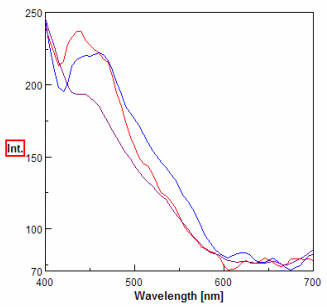
These security threads make it difficult to copy currency with a commercial color copier. Using a unique thread position for each denomination starting with the $100 note prevents certain counterfeit techniques, such as bleaching ink off a lower denomination and using the paper to “reprint” the bill as a higher value note. Table 1 designates the color of the emitted fluorescence of the security threads.
| Denomination | Fluorescence of Security Thread |
|---|---|
| $50 | Yellow |
| $20 | Green |
| $10 | Red |
| $5 | Blue |
Table 1. Security threads in US Currency
Experimental
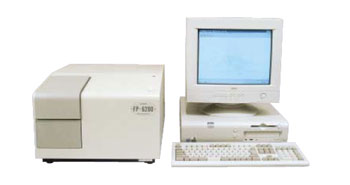
An FP-6200 fluorescence spectrophotometer fitted with a solid sample holder accessory was used for all analyses. The solid sample holder is kinematically mounted in the instrument sample compartment to provide the proper orientation of the sample to the excitation and emission ports. Bills of denomination $5, $10, $20 and $100 were placed in the sample holder such that the security thread was exposed to the excitation beam. Emission scans of both sides of each bill were collected and several locations on the security thread for each bill were also examined. The background fluorescence of the bill was subtracted from each scan of the security thread. Figure 2 illustrates the solid sample holder.
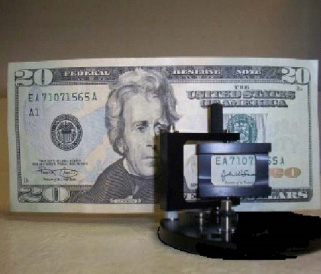
Spectra were collected from 400-565nm. Instrument parameters were as follows:
| Band width: | Band width: |
| Measurement range: | 400 - 600 nm |
| Data pitch: | 1nm |
| Excitation wavelength: | 365.0 nm |
| Scanning speed: | 125 nm/min. |
Representative scans of the security threads are shown in Figure 3. The emission bands are wide and distinctly identify each bill. The fluorescence intensity of the security threads appeared to decrease with apparent use and handling of the bills, as newer bills displayed a stronger fluorescence intensity. The fluorescent threads examined in this study did not have a uniform intensity along the length of the thread. This suggests that fluorescence could be used for quality control of the production of these security devices.
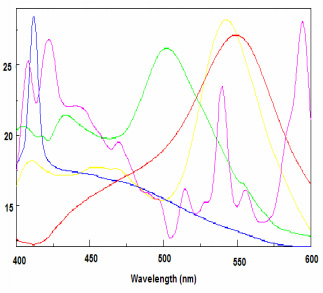
Conclusion
Simple fluorescence instrumentation can be used to evaluate the authenticity of U.S. currency. Using a fluorescence instrument as shown, the signal from the bill and its inherent security thread can be monitored to ensure currency validity and possibly provide a method for the examination of aging of a bill.
Featured Products:
-
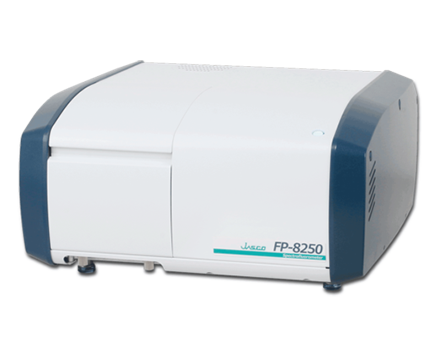
Simple and sensitive system which readily accommodates routine measurements and accessories, such as spectral scanning, quantitation, and temperature control.
FP-8250 Spectrofluorometer
-
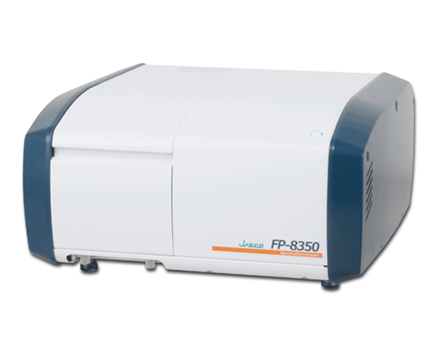
A powerful combination of performance, sensitivity and flexibility for biological, environmental and materials analysis.
FP-8350 Spectrofluorometer
-
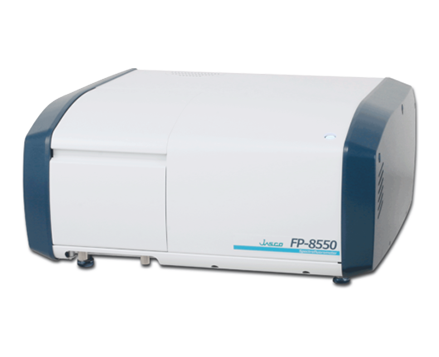
Sophisticated optical system offering the ultimate in sensitivity, spectral accuracy, and flexibility for the most challenging materials and biological samples.
FP-8550 Spectrofluorometer

Fluorescence Detection in the Detection of Counterfeit US Currency
Introduction
Each year, significantly more money is stolen with a pen than with a gun. Much of the fraud is due to counterfeiting since the current technology available for personal computers, scanners, and color copiers have attained the capability to accurately reproduce paper currency. Counterfeit currency costs governments and businesses billions of dollars a year. During fiscal year 1997 alone, a total of $136,205,241 in counterfeit U.S. currency appeared worldwide.
This application demonstrates how a simple fluorescence instrument can be used to verify the identity of currency through the presence of the security thread and the background fluorescence of the bill. This fluorescence intensity can also be used to study the aging and manufacturing reproducibility of currency.
The United States currency is the most counterfeited currency in the world with the Canadian dollar a close second, these currencies are popular due to their status as a ‘hard’ currency, similar to gold. Large numbers of bills in all denominations are counterfeited and passed to unsuspecting merchants and banking institutions. In the past, only large denominations like the $100 and $50 bill were counterfeited. Recently, however, numerous businesses report the receipt of counterfeit $5, $10, and $20 notes with the $20 note being passed with the highest frequency.
One of the most common types of counterfeit detection is provided by ultraviolet (UV) light. The principle is simple; if the bill being checked has fluorescence then it is genuine. The idea behind this is that the paper used in the printing of real currency has a high starch content making it appear dull under UV light. Counterfeiters generally use bond paper that has virtually no starch and is bleached. The bleached bond paper fluoresces under UV light. The characteristic background fluorescence of all the US currency studied is shown in Figure 1.
UV detection of counterfeit currency has been in use since approximately 1976, and has been fairly effective. Recently, a new security measure, a security thread, has been implemented to prevent counterfeiters from passing off a bill as one of a higher denomination. A security thread is a thin thread or ribbon running through a bank note. The thread in U.S. currency includes printing and on the new $50 note, micro-printing and graphics.
The thread in the new notes glows when held under an ultraviolet light. In the $100 note it will glow pink, and in the $50 note it glows yellow. In addition, it is visible in transmitted light, but not in reflected light.

These security threads make it difficult to copy currency with a commercial color copier. Using a unique thread position for each denomination starting with the $100 note prevents certain counterfeit techniques, such as bleaching ink off a lower denomination and using the paper to “reprint” the bill as a higher value note. Table 1 designates the color of the emitted fluorescence of the security threads.
| Denomination | Fluorescence of Security Thread |
|---|---|
| $50 | Yellow |
| $20 | Green |
| $10 | Red |
| $5 | Blue |
Table 1. Security threads in US Currency
Experimental

An FP-6200 fluorescence spectrophotometer fitted with a solid sample holder accessory was used for all analyses. The solid sample holder is kinematically mounted in the instrument sample compartment to provide the proper orientation of the sample to the excitation and emission ports. Bills of denomination $5, $10, $20 and $100 were placed in the sample holder such that the security thread was exposed to the excitation beam. Emission scans of both sides of each bill were collected and several locations on the security thread for each bill were also examined. The background fluorescence of the bill was subtracted from each scan of the security thread. Figure 2 illustrates the solid sample holder.

Spectra were collected from 400-565nm. Instrument parameters were as follows:
| Band width: | Band width: |
| Measurement range: | 400 - 600 nm |
| Data pitch: | 1nm |
| Excitation wavelength: | 365.0 nm |
| Scanning speed: | 125 nm/min. |
Representative scans of the security threads are shown in Figure 3. The emission bands are wide and distinctly identify each bill. The fluorescence intensity of the security threads appeared to decrease with apparent use and handling of the bills, as newer bills displayed a stronger fluorescence intensity. The fluorescent threads examined in this study did not have a uniform intensity along the length of the thread. This suggests that fluorescence could be used for quality control of the production of these security devices.

Conclusion
Simple fluorescence instrumentation can be used to evaluate the authenticity of U.S. currency. Using a fluorescence instrument as shown, the signal from the bill and its inherent security thread can be monitored to ensure currency validity and possibly provide a method for the examination of aging of a bill.

 Download This Application
Download This Application